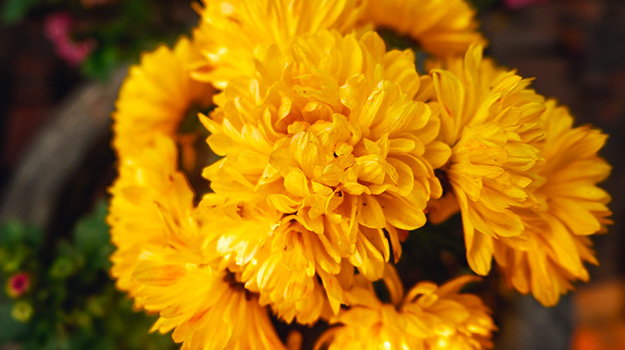
In areas where the gardening season is short, you want to make the most of it. Decks and balconies can be an integral part of our interiors, for more or less 6 months a year. We like to decorate them with pots, window boxes, tubs… We establish various plants there and we create arrangements that will delight us with their colours, their scent and their flavour during the months to come.
Besides annuals, herbs and vegetables, the urban garden here is reinventing itself. Like what has been done elsewhere in the world, we are adding trees, shrubs and perennials, taking over paved or concrete surfaces, transforming them into a cool oasis or a lush jungle.
Which pot to choose?
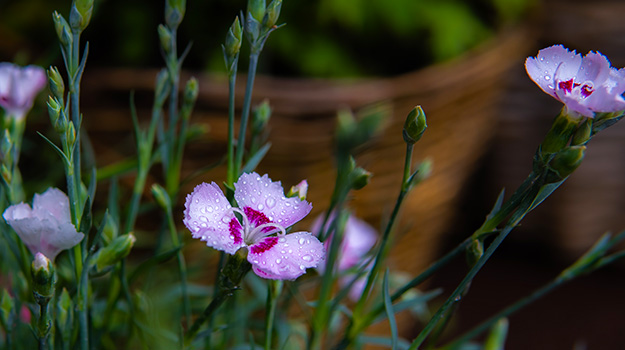
Select pots that are deep enough and wide enough to meet the needs of your plants. The correct size must allow your plant roots to have access to a reserve of water and nutrients. If you use a deeper pot, the roots will develop more to draw water and nutrients from the depths and will have less tendency to twist. As a bonus, with the right potting soil and with a bigger pot, you will need to water less!
OUR ADVICE: It is well known that dark colours absorb more heat. In sunny places, place light-coloured containers. The light colour will prevent the pot from getting hot, which will reduce water needs.
Stores and garden centres are full of pots. Realize, however, that anything that will contain soil is suitable for growing in pots, provided of course that it is of adequate size and has drainage holes.
The drainage holes make it possible to efficiently drain excess water to prevent the roots from rotting. Even if you water carefully, heavy rain will quickly drown plants planted in a pot with insufficient drainage.
If needed, you can enlarge the holes or add 2 or 3 of one to two centimetres in diameter. (The ideal ratio for drainage would be a 1.5-cm hole every 25 cm.) You can use a drill fitted with a mason bit for ceramic pots. To prevent the drill bit from slipping, apply tape where you plan to drill. To prevent the pot from cracking, start with a 3-mm drill bit, then gradually enlarge the hole by changing the drill bit.
OUR ADVICE: Beware of ceramic pots! The prettiest ones are often sold as solid containers and don't have a hole in the bottom. If you use this kind of pot, don’t forget to make drainage holes.
Perennials are moved onto the deck!

Growing perennials in pots, what a great idea! Like annuals, perennials make it possible to compose sumptuous arrangements to adorn balconies and decks. Their advantage? They can be used year after year. Just put them in the ground in the garden in the fall, before the first frosts, with or without their pot. They will resume their place when spring returns!
The annuals that adorn our planters are also perennials in their southern countries of origin, closer to the equator. The plants which our garden centres offer us under the label of “annual” and which die here at the end of a season thrive for years in milder temperatures.
How to choose your plants?
It is possible to combine different plants in the same pot. To facilitate cohabitation and ensure their development, group plants that have the same needs and characteristics (soil type, water, fertilizer, sunshine, wind tolerance, etc.). This will make it easier for them to live together.
Also, remember that the conditions are not the same depending on the location chosen. For example, on a high balcony, a tall plant with fragile stems will be more exposed to the winds than one on a deck, more protected at ground level. Similarly, if considering an asphalt surface in full sun, it will be beneficial to choose plants that tolerate drought well.
TIP: For a spectacular result every time, choose a tall “star” plant to place in the centre of the container. Then surround it with two to three ornamental plants, and finish with planting two to three vines with a hanging habit at the edge of the pot. Think of grasses to add height and obviously include annuals to prolong flowering!
In the case of a less elaborate composition, you could opt for an unusual composition including coloured foliage.
Create with foliage… more foliage!
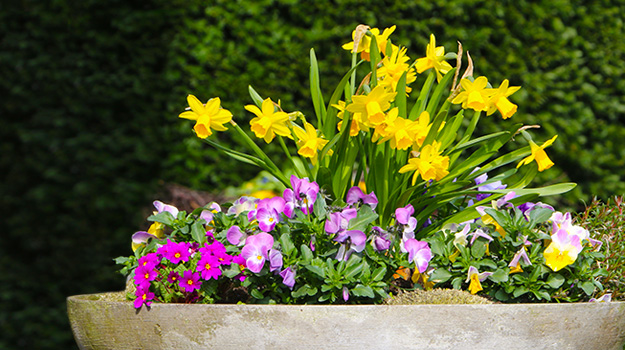
A harmonious arrangement offers a balanced marriage of different textures, shapes and colours of foliage. With a little variety, the plants you love will be the basis of a unique composition that will cause a stir. As with annuals, their need for sunlight will guide you to the type of plant to use.
Which perennials are best for growing in containers?
It all depends on the desired effect. Nevertheless, since perennials flower for a shorter period of time than annuals, we should choose our plants for the beauty of their foliage and consider their flowering as a bonus. With their rich colours of yellow, burgundy, lime, etc., the foliage of perennials presents incredible possibilities. Match colours, combine shapes and textures, enjoy scents.
Have fun! Perennials let you explore new avenues that annuals can't.
What is the ideal size for the pot?
Your pot should have a diameter and a height of at least 30 cm. A wide base will give it more stability. Hanging baskets should have a diameter of at least 40 cm and a depth of 20 cm. As for planters, they should be 20 cm deep, and their length should not exceed 1.2 m.
Obviously, if you decide to create a beautiful arrangement showcasing tall plants like grasses, or very greedy ones like asters, you will need a more spacious pot!
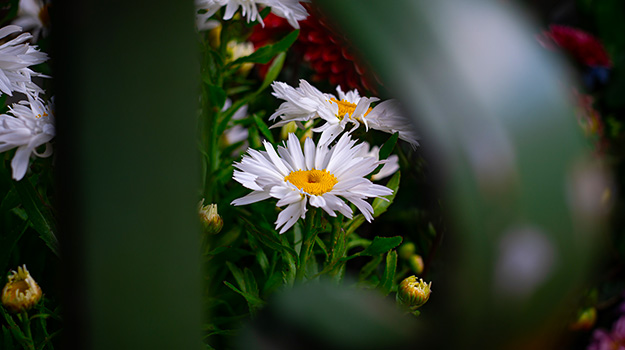
A few suggestions to get started:
- Use your surplus from spring divisions of your perennials; you will save a lot of cost and if it doesn’t turn well and the plant does not bloom or grow less than expected, you haven’t lost money.
- Keep an eye out the next time you visit the garden centre! If a plant looks good in its pot on a shelf, it will certainly look good in a pot on your balcony. However, be sure to transplant it. If the plant has spent a lot of time in its pot, the roots may be cramped and more than likely it has exhausted all the nutrients. PRO-MIX Premium Potting Mix with MYCOACTIVE technology has everything it needs.
- Adopt good habits, both for fertilizing and watering. By opting for a potting soil with sphagnum peat moss, you’ll reduce water needs and your plants tolerate high heat better.
- Do you tend to forget to water? Unlike annuals, whose water needs are more often similar, perennials offer the possibility of making up arrangements that are more resistant to drought. You can opt for alpine plants that work wonders in rockeries!
- For places exposed to the wind, avoid tall perennials whose fragile stems can break. If you want height, prefer flowers on long, flexible stems that will sway in the wind without breaking.
- Planting in pots is a great option for controlling invasive perennials such as certain grasses that you quickly lose control of in the garden.
- Be careful not to combine competitive plants with less combative species since they will make short work of it. Some plants benefit from being grown alone in their pot!
Here are some suggestions for perennials that will make a splash in containers: lavender, hosta, bellflower, phlox, ornamental garlic, coral bells, acorus, artemisia (try creepers!), spurge, grasses, ferns, saxifrage, sedum, hens and chicks, and yucca.
Growing shrubs in pots
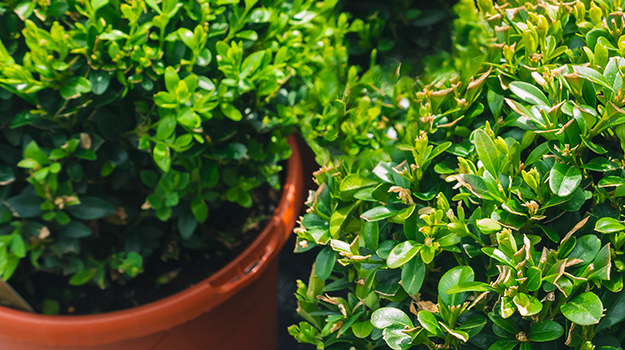
Yes, some shrubs can also be grown in pots, so there's no need to deprive yourself of their presence just because you're growing on a balcony or deck. No one will be surprised to learn that flowering shrubs are popular!
Growing plants in containers allows you to move them as you wish, throughout the season, whether to follow the sun, facilitate garden maintenance or simply to rearrange the yard as you wish, on impulse!
Here are some suggestions for shrubs that are easy to grow in containers and work wonders in an urban garden.
Hibiscus
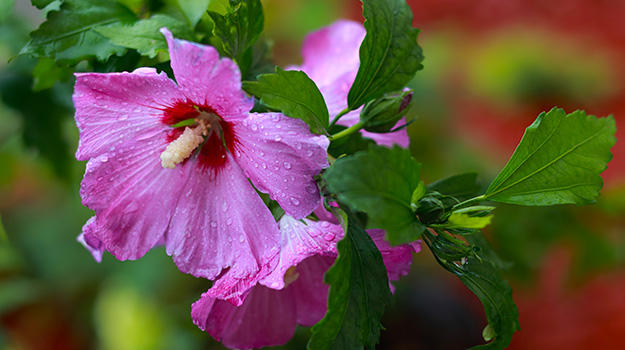
There are perennial varieties and others that are not. Moreover, stem-grafted cultivars are grown as houseplants even though they enjoy being on the patio during the summer season. The varieties considered as indoor plants will have to be brought in in the fall while the perennials will survive the winter provided they are planted before the first frost.
Japanese andromeda
We love its evergreen foliage which allows you to enjoy it longer, and its new pink, bright red or coppery spring shoots. Depending on the cultivar, this slow-growing shrub can vary in size (50 cm to 150 cm), offer white or pink flowers, and even have variegated green and cream foliage.
Evergreen heather
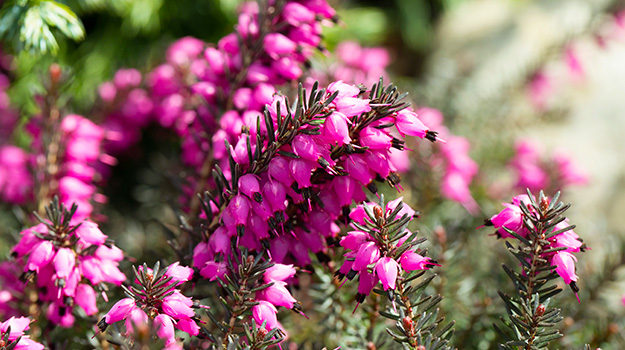
Heathers look like tiny conifers. However, they have the advantage of offering abundant flowering in the form of tiny bells. Their fall colouring is simply spectacular, ranging from orange to flame red. Although there are two main species, autumn heathers are more often grown in containers.
Japanese azalea and rhododendron
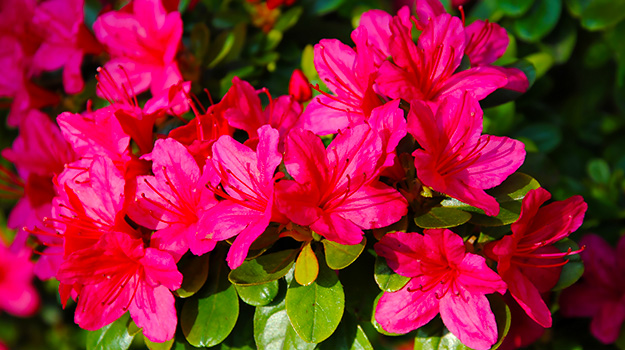
Nothing better to light up a sad corner than a shrub whose flowering is both spectacular and early. Their size may vary, but they never disappoint because of their impressive colours of white, pink, salmon, fuchsia, yellow, red or orange flowers. Depending on the space available, one can choose dwarf or slow-growing varieties. They can be grown in sun or partial shade.
Snowball viburnum
It is sometimes confused with the Annabelle hydrangea with similar snowball flowers. However, the viburnum flowers in May and June rather than in the summer. In the fall, its foliage takes on an astonishing wine colour that is sure to attract attention. The viburnum lives both in the sun and in partial shade.
Daphne
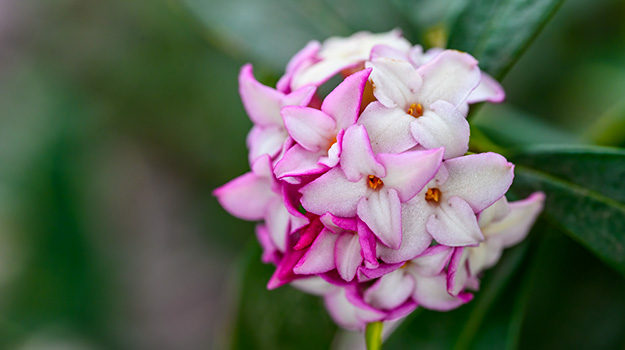
Less known than other shrubs, daphne deserves to be introduced into our landscapes, whether in the ground or in containers. Depending on the species, it may have evergreen foliage, pretty and fragrant flowers, have a creeping habit, prefer shade or sun... Daphne does not like to be pruned and, depending on the cultivar chosen, it may require more winter protection that goes beyond simple grounding.
Other suggestions :
Spirea, hydrangea, serviceberry, alternate-leaved dogwood and Flowerfesta Pink lilac, a repeat-flowering dwarf variety that will make a splash on the balcony. We also think of small conifers: yew, junipers, mugo pine and other dwarf varieties. In the case of conifers, for the winter, they should be protected from drying winds that will cause the needles to turn yellow or red.
Growing a tree in a pot
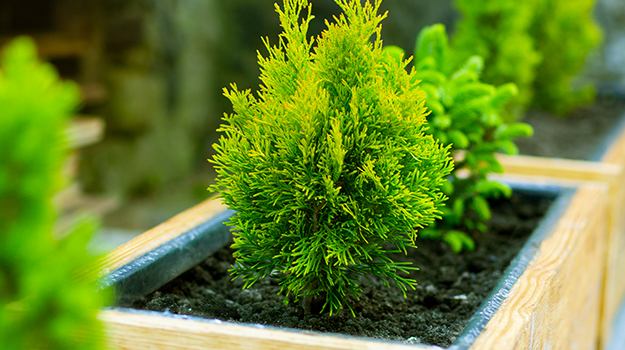
If the idea of growing a tree in a container seems strange to you, know that it has been a common practice in China for almost 2000 years. In Europe, several varieties are also grown in pots, as is the case with lemon trees in the Mediterranean region. Closer to home, we've seen this phenomenon for so long in shopping malls and office buildings, we don't even notice them anymore. Why not do the same at home?
To be able to thrive outdoors in an urban garden, container-grown trees must meet certain criteria, considering our variable climate. It will also be necessary to commit to providing them with the water and fertilizer necessary for their development, since their roots will not be able to draw them from the ground. Finally, expect to have to provide more care to potted trees than they would require if they were growing in the ground.
Here are the 3 rules to follow to successfully plant potted trees.
1. Plant carefully
The planting height is essential. The collar – where the stem joins the roots, or the top of the root ball – should be at surface level. Add potting soil around the trunk until the level of the soil is 2 or 3 cm from the edge of the pot. This will prevent water from overflowing when you water. Compress lightly, but do not compact.
2. Prune the roots that spiral
When you transplant your tree, if the roots are abundant and completely surround the root ball, prune them in places using disinfected and very sharp pruning shears. This will promote the development of new, healthy, better oriented roots.
3. Water thoroughly
Water gently to avoid creating fissures in the soil, until the water begins to flow through the drainage holes. If air pockets have formed, the water will eliminate them and all you have to do is add a little potting soil. Level the surface without compressing and water again.
TIP: You can put mulch at the foot of your tree, taking care that it is not in contact with the trunk. Water will evaporate less quickly, and weeds will have a harder time establishing themselves.
Your tree's roots cannot draw the nutrients it needs from the soil. You must provide them with a regular addition of compost or organic-based fertilizer such as PRO-MIX Multi-Purpose Garden Fertilizer 20-8-8 or PRO-MIX Flower Boost Garden Fertilizer 12-28-12. Fertilizer will help your tree thrive.
After five years, it would be a good idea to repot your tree into a larger pot. If the roots form spirals around the root ball, prune them again. Add a rich potting mix containing a slow-release fertilizer such as PRO-MIX Premium Potting Mix.
To add accent to your pot, or to prevent weeds from settling there, you can cover the soil with mulch (avoiding putting it against the trunk), but also with ornamental rocks, driftwood, twisted branches...
The cultivar chosen should be able to survive in a hardiness zone lower than yours, even if you plan to bury the pot in late fall. If the tree grows, and its pot grows, there may come a time when you can no longer do this. When the pot can no longer be buried for the winter, it is laid on the ground and the tree is covered with a geotextile fabric that will protect it from high winds and the vagaries of temperature.
What trees can be grown in a container?
For obvious reasons, fast-growing trees are not suitable for container growing. If you also grow fruits and vegetables, choose trees and shrubs that attract pollinators. They will promote a bountiful harvest.
Scotch pine
Even though the Scotch pine grows very tall, you can have fun trimming it artistically, which makes it an interesting tree for growing in containers. Very resistant, it can live 50 years in a container.
Dwarf apple tree
Yes, you can grow apple trees in pots! You can opt for a dwarf or semi-dwarf apple tree. Make sure that there is another one nearby to ensure its pollination, or it will not produce fruit. Otherwise, you can look for a self-fertile grafted apple tree that combines different varieties on the same plant. It will also have the advantage of offering you a diversified and prolonged harvest.
Crabapple
You can also choose from a fine selection of crabapple trees in various colours and whose flowering will dazzle you year after year.
Conifers
As for the conifers, you should be tempted by the false cypress, cedar, hemlock and spruce. For a zone 5, select plants hardy in a zone 3 or 4.
Overwintering in pots
It is important to know that your plant, whatever it is, will always be less hardy when it grows in a pot than if you grow it in the ground. If you live in a zone 5, select plants hardy for zone 3 or 4.
If you want to keep your plants from one year to the next, put your perennials and small shrubs in the ground, with or without their pots, at the end of fall. Their roots will be better protected from the cold and will not be as sensitive to the drastic temperature differences common in more northern regions.
Large shrubs or trees, the pots of which cannot be buried, should be laid on the ground, in a place receiving good snow cover and ideally protected from the winds and the spring sun. They should be covered with a thick mulch of leaves held in place by a net, or geotextile.
If you have the space available, you can also move your potted trees and shrubs into the garage for the winter season.
Thus protected, your plants will be able to resume their place on the deck or patio the following spring.
OUR TIP: Make sure your pots are frost-resistant! Reconstituted stone, plastic and wood are, while terracotta is only under certain conditions.
